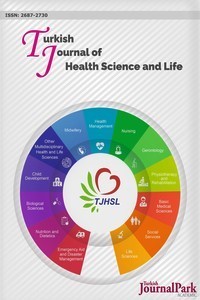THE USE OF COMPLEMENTARY AND ALTERNATIVE MEDICINE METHODS AND TRADITIONAL METHODS IN PAIN CONTROL IN TURKEY
THE USE OF COMPLEMENTARY AND ALTERNATIVE MEDICINE METHODS AND TRADITIONAL METHODS IN PAIN CONTROL IN TURKEY
___
- 1. The International Association for the Study of Pain. (2018). Retrieved September 2, from http://www.iasp-pain.org/
- 2. Güngörmüş Z. & Kıyak E. (2012). Evaluation of the knowledge, attitude and behaviors of individuals who suffer from pain towards complementary and alternative medicines. Ağrı, 24: 123-129.
- 3. Araz A., Harlak H. & Meşe G. (2007). Health behaviors and alternative medicine use. TSK Koruyucu Hekimlik Bülteni, 6:112-22.
- 4. World Health Organization (2018). Traditional, complementary and alternative medicine: policy and public health perspectives. Retrieved September 10, from http://www.who.int/bulletin/volumes/86/1/07-046458/en/
- 5. Muslu G.K. & Öztürk C. (2008). Use of complementary and alternative therapy in children and evaluation of parental information. Çocuk Sağlığı ve Hastalıkları Dergisi, 51: 62-7.
- 6. Çöl Araz N., Taşdemir H.S. & Parlar Kılıç S. (2012). Evaluation of opinions of the faculty of health sciences students about non medical alternative and traditional therapies. Gümüşhane Üniversitesi Sağlık Bilimleri Dergisi, 1:240-51.
- 7. Ergin A., Hatipoğlu C., Bozkurt A.I., Mirza E., Kunak D., Karan C., et al. (2011). Knowledge and attitudes of residents and medical students on complementary-alternative medicine. Pam Med J, 4: 136- 43.
- 8. Akçay F., Aktürk, Z. (2010). Complementary and alternative medicine for gastrointestinal diseases. Türkiye Klinikleri J Fam Med-Special Topics, 1: 68-75.
- 9. Kutlu S., Ekmekçi T.R., Köşlü A. & Purisa S. (2009). Complementary and alternative medicine among patients attending to dermatology outpatient clinic. Türkiye Klinikleri J Med Sci, 29:1496-502.
- 10. Bülbül S.H., Turgut M. & Köylüoğlu S. (2009). Parents’ views about alternative practices in children. Çocuk Sağ Hast Derg, 52: 195-202.
- 11. Erin N. (2006). Complementary and alternative medicine: Nurse practitioner education and practice holistic. Nurs Prac, 20: 242-246.
- 12. Aktaş B. (2017). Attitudes of nursing students toward holistic complementary and alternative medicine. JAREN, 3: 55-59.
- 13. Tokem, Y. (2006). The use of complementary and alternative treatment in patients with asthma. Tüber Toraks Derg, 54, 189-96.
- 14. Özcelik, H., Fadıloğlu, C. (2009). Reasons for use of complementary and alternative medicine in cancer patients. Türk Onkoloji Dergisi, 24, 48-52.
- 15. Öztürk, M., Uskun, E., Özdem, R., Çınar, M., Alptekin, F., Doğan, M. (2005). Public interest to traditional medicine in Isparta. Türkiye Klinikleri J Med Ethics, 13, 179-186.
- 16. Somer, P., Lut, E. (2017). A Legal and ethical evaluation of the regulations on traditional and complementary medicine. Anadolu Kliniği, 22, 58- 67.
- 17. Mollahaliloğlu S., Uğurlu G., Kalaycı M. & Öztaş D. (2015). The new period in traditional and complementary medicine. Ankara Medical Journal, 15: 102-105.
- 18. Arıkan D. & Aytekin, A. (2007). The effects of mothers age and educational level on pediatric pain control applications with non-phar-macological methods. Atatürk Üniversitesi Hemşirelik Yüksekokulu Dergisi. 10: 4-12.
- 19. Korhan E.A., Uyar M., Eyigör C., Hakverdioğlu G., Çelik S. & Khorshid, L. (2014). The Effects of Music Therapy on Pain in Patients with Neuropathic Pain. Pain Management Nursing, 15: 306-314.
- 20. Efe E., Öncel S. &Yılmaz M. (2012). Women’ approach to child that teeth, abdomen and earache. Ağrı, 24: 69-76.
- 21. Özçelik, G., Toprak, D. (2015). Why is phytotherapy preferred? Ankara Medical Journal, 15, 48-58.
- 22. Ozer, O., Şantaş, F., Yıldırım, H. (2013). An evaluation on levels of knowledge, attitude and behavior of people at 65 years and above about alternative medicine living in Ankara. Afr J Tradit Complement Altern Med, 10, 134-141.
- 23. Furlan A.D., Yazdi F., Tsertsvadze A., Gross A., Van Tulder M., Santaguida L., et al. (2012). A systematic review and meta-analysis of efficacy, cost-effectiveness, and safety of selected complementary and alternative medicine for neck and low-back pain. Evidence- Based Complementary and Alternative Medicine, 1: 1-62.
- 24. Murthy V., David W. & Adams J. (2015). An integrative review of complementary and alternative medicine use for back pain: a focus on prevalence, reasons for use, influential factors, self-perceived effectiveness, and communication. The Spine Journal, 15: 1870– 1883.
- 25. Kanodia A., Legedza A.T., Davis R.B., Eisenberg D.M. &Phillips R.S. (2010). Perceived benefit of complementary and alternative medicine (CAM) for back pain: a national survey. J Am Board Fam Med, 23: 354 –362.
- 26. Frank H.L. & Srinivasa N.R. (2011). Complementary and alternative medicine in chronic pain. Pain, 152:28-30.
- 27. Barnes P.M., Bloom B. &Nahin R. L. (2008). Complementary and alternative medicine use among adults and children: United States 2007. Natl Health Stat Rep, 12: 1-23.
- 28. Fleming S., Rabago D.P., Mundt M.P. & Fleming M. F. (2007). CAM therapies among primary care patients using opioid therapy for chronic pain. BMC Complement Altern Med, 7:15-19.
- 29. Cheung C.K., Wyman J.F. & Halcon L. L. (2007). Use of complementary and alternative therapies in community-dwelling older adults. J Altern Complement Med, 13: 997-1006.
- 30. Ndao-Brumblay, S. K., Green, C. R. (2010). Predictors of complementary and alternative medicine use in chronic pain patients. Pain Med, 11, 16-24
- 31. Rosenberg, E. I., Genao, I., Chen, I., Mechaber, A. J., Wood, J. A., Faselis, C. J, et al. (2008). Complementary and alternative medicine use by primary care patients with chronic pain. Pain Med, 9, 1065-1072
- 32. Melikoğlu G., Kurtoğlu S. & Kültür Ş. (2015). Plants traditionally used in Turkey in Asthma. Marmara Pharmaceutical Journal, 19: 1-11.
- ISSN: 2687-2730
- Başlangıç: 2018
- Yayıncı: Mümin POLAT
EARLY CHILDHOOD CARIES RISK FACTORS
COLIC SCALE SCORES AND ASSOCIATED FACTORS IN INFANTS DIAGNOSED WITH INFANTILE COLIC
IRON DEFICIENCY AND ANEMIA IN HEART FAILURE
Canan DEMİR BARUTCU, Zeynep KIVRAK
EVALUATION OF DIGITAL LITERACY STATUS OF UNIVERSITY STUDENTS
Nurvet BÜYÜKYÖRÜK, Kerime ÖĞÜT DÜZEN
Yusuf KARATAŞ, Zakir KHAN, Gönül PEKKAN, Çağrı BİLEN, Ezgi Sena GÖREN ÖZAGİL, Ayşe Büşra ABUSSUUTOĞLU
